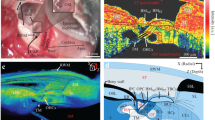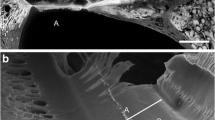Summary
Changes in the ultrastructure of the cochlea due to postmortem autolysis make the assessment of the normal or damaged anatomy difficult. Three methods of preserving the human cochlea were compared on the basis of the state of preservation of the sensory cell hairs of the organ of Corti as seen in the scanning electron microscope. Perfusion of the perilymphatic space with a glutaraldehydeformaldehyde fixative within 40 min of death gave preservation as good as that seen in animal studies. Injecting formalin into the middle ear within 40 min of death allowed artefacts to develop when compared with the control ear which had been perfused with fixative. Refrigeration and early removal of the temporal bone gave poor preservation of surface structures.
Similar content being viewed by others
References
Bredberg G (1968) Cellular pattern and nerve supply of human organ of Corti. Acta Otolaryngol [Suppl] 236:34–35
Engstrom H, Ades HW, Bredberg G (1970) Sensori neural hearing loss. Churchill, London, p 155
Fernandez C (1958a) Postmortem changes and artifacts in human temporal bones. Laryngoscope 68:1586
Fernandez C (1958b) Postmortem changes in the vestibular and cochlear receptors. Arch Otolaryngol 68:466–487
Hoshino T (1977) Contact between the tectorial membrane and the cochlear sensory hairs in the human and monkey. Arch Otorhinolaryngol 217:53–60
Hunter-Duvar IM (1978) Electron microscopic assessment of the cochlea. Acta Otolaryngol [Suppl] 351:18–20
Karnovsky MJ (1965) A formaldehyde-glutaraldehyde fixative of high osmolarity for use in the electron microscope. J Cell Biol 27:137A
Kimura RS, Schuknecht HE, Sando I (1964) Fine morphology of the sensory cells in the organ of Corti of man. Otolaryngol 58:390–408
Lim DJ (1976) Ultrastructural cochlea changes following acoustic hyperstimulation and ototoxicity. Ann Otolaryngol 85:740–751
Nomura Y, Kawabata I (1978) The pathology of sensory hairs in the human organ of Corti. In: Scanning electron microscopy, 1978/11. IITRI, Chicago, pp 417–422
Nomura Y, Kawabata I (1978) Loss of stereocilia in the human organ of Corti. Arch Otorhinolaryngol 222:181–185
Rutledge LJ (1969) Histologic studies of perfused human temporal bones. Laryngoscope 79:2104–2125
Schuknecht HF (1974) Pathology of the ear. Harvard University Press, Cambridge MA, pp 14–16
Author information
Authors and Affiliations
Additional information
This work has been supported by grants from the Medical Research Council of Great Britain and by the Merseyside Regional Health Authority
Rights and permissions
About this article
Cite this article
Wright, A. Scanning electron microscopy of the human cochlea — Postmortem autolysis artefacts. Arch Otorhinolaryngol 228, 1–6 (1980). https://doi.org/10.1007/BF00455888
Received:
Issue Date:
DOI: https://doi.org/10.1007/BF00455888




